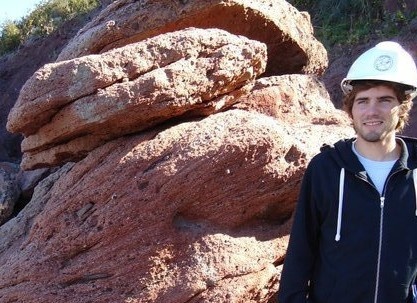Peter Regan

M. Sc. Thesis
(PDF - 230 Mb)
Shear zones are tabular structures of higher strain and vorticity relative to the country rock. Shear zones appear globally, at all scales, and commonly link together to form complex anastomosing patterns. The processes by which shear zones nucleate, propagate, and form networks have been studied extensively, but predominately in isotropic materials. The Twelve Mile Bay shear zone, located in the ca. 1.0 Ga Grenville orogen in Ontario, Canada, is a shear zone system developed with anisotropic rocks of the interior Parry Sound domain (iPSD). Granulite facies layering of the southern margin of the iPSD is transposed by a series of increasingly connected amphibolite facies shear zones within a five kilometer wide zone of progressive deformation, preserving several stages of shear zone development, resulting in the regional-scale shear zone between the iPSD and the lower Go Home domain. Outcrops were digitally imaged using innovative aerial photography and open source software to create high-resolution georeferenced aerial photo mosaics of several islands. Photo mosaics enabled quantitative measurement of strain along shear zones and their geometries at various stages of shear zone development. Measurements show an increase in shear strain (帠avg) proximal to the Twelve Mile Bay shear zone and reveal a bimodal distribution of extension directions, from NNE-SSW at the start of the zone of transposition, to E-W toward the Twelve Mile Bay shear zone where transposition is complete. Folds within wall rocks at several stages of transposition revealed that fold hinges originate in a steeply plunging orientation and are reoriented into the shallowly plunging, E-W oriented, regional extensional direction of the Twelve Mile Bay shear zone (~E-W). This study proposes a conceptual model for the main stages of transposition along the southern margin of the iPSD: i) brittle fracture-filled pegmatite dykes introduced hydrated planes of weakness; ii) initial dextral shear zone developed along pegmatites; iii) sinistral shearing at a high angle to dextral shear zones that amplified pre-exisiting dextral shear zones and introduced internal wall rock deformation; iv) folded wall rock blocks are increasingly deformed and rotated into the regional extensional direction causing shear zone widening, which led to an increasingly linked shear zone network; and, v) complete transposition of iPSD layering to the shear zone fabric with rare pods of iPSD fabric.
Keywords: structural geology, parry sound domain, photogrammetry, grenville province, transposition, shear zones
Pages: 188
Supervisor:泭Nicholas Culshaw



